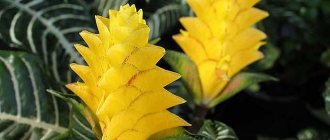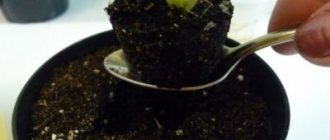The herbaceous perennial plant pyrethrum (Pyrethrum) is a member of the Asteraceae or Asteraceae family. This genus includes approximately 100 species. All these species have one common feature - the color of the reed flowers is white or pink. This plant is native to Europe, Asia and North America. This plant received its scientific name due to the fact that some species have healing properties, or rather, they are able to reduce body temperature (“pyretos” translated means “heat, fever”). Popularly, these flowers have other names, for example: chamomile, popovnik or chamomile.
Description
The name comes from pyretos, which translates into Russian as “fever”. Some species are actually used in medicine as powerful antipyretics. It was first mentioned in the articles of Dioscarides (1st century AD) as an effective medicine for headaches and arthritis. In the 17th century, the tanacetum flower was recognized as the best remedy for migraines.
Feverfew
People often confuse it with chamomile and call it chamomile because of its similarity with another species. Depending on the variety, the length varies from 5 (dwarf varieties) to 150 centimeters (tall varieties). Flowers can be either simple or double or semi-double. Various colors: yellow, red, crimson. They are grown in mixborders and flower beds, next to trees and other crops. Strengths include:
- A long flowering period – it pleases with bright colors all summer long.
- Unpretentiousness.
- Frost resistance.
If you're short on time or just getting started with flowers, planting and caring is the perfect solution. Visually, it looks like a chamomile and will appeal to fans of this culture. The difference is in the variety of colors and a more lush core.
Reproduction
Types of reproduction of pyrethrum, as well as in coreopsis whorled:
- Dividing overgrown bushes;
- Cuttings;
- Seeds.
As for dividing, it is best to do this after the plant has flowered. First of all, bushes that begin to lose the beauty of their flowering must be divided.
Cuttings are usually used when propagating very rare and slow-growing varieties.
The simplest method is propagation by seeds. Seeds remain viable for up to three years. They are sown for seedlings in March at a shallow depth, in light, moist soil, with a distance of 2-3 cm, to facilitate subsequent picking. The first shoots appear already on the 11th day. To prevent the seedlings from stretching, after germination they need to be moved to a cooler and brighter place. Flowering begins in this case after 80 -100 days. But stronger seedlings are obtained when sowing seeds in open ground before winter.
How does it reproduce?
To increase the population, use any of the following methods:
- Division. As soon as the bush has bloomed, dig it up and carefully shake off the soil from the roots. They are divided into several rosettes, which are planted separately. Care is the same as for adult specimens. Experienced gardeners advise dividing regularly. The procedure promotes rejuvenation.
Planting maiden primrose - Cuttings. For propagation, root shoots are taken. Cuttings are rooted in the summer, but choose a shaded place and cover with film. Then the young seedlings will not dry out.
- Seeds. For a plant such as pyrethrum, growing from seeds is also relevant. But the problem is that daughter bushes often lose the characteristics of their parents. If you just need to decorate the area with new flowers, feel free to sow the collected seeds. If the priority is to preserve the existing characteristics of the variety, try propagation by other methods.
Chemical composition
The valuable properties of maiden tansy are due to its rich chemical composition. The leaves, flowers and seeds of the plant contain:
- alkaloids and glycosides;
- polysaccharides;
- vitamin C;
- tannins;
- gallic and tanacetic acids;
- proteins;
- esters;
- routine;
- carotenoids;
- pinene and thujone;
- borneol;
- camphor.
Some substances in maiden tansy are toxic. In minimal dosages they have a therapeutic effect, but if consumed in excess they cause severe harm to the body.
Growing
Let's look at propagation by seeds in detail. The pyrethrum plant has small seeds. To simplify sowing, they are mixed with sand. Sowing is carried out in early spring, deepening the seeds by 5 mm. To simplify the task, the seeds are simply scattered over the surface in an even layer. For watering use a spray bottle. The container is covered with film, but you can limit it to glass, and place it in a sunny and warm place (+20). When the seedlings appear, the glass is removed. Picking begins after the appearance of the second leaf. Before planting, they are hardened for two weeks.
Autumn sowing
Residents of the southern regions can grow the flower using the seedless method. Seeds are sown in September, germination rate is high. The seeds are not soaked, but the soil is loosened. Lay a groove five centimeters deep and moisten it well. Scatter the seeds in a thick layer and place a little soil on top. There is no need to make a shelter. The seeds quickly take root and overwinter well. Already in March they will delight you with bright buds.
Features of care. Watering
As mentioned above, the “chamomile double” is completely unpretentious in care. It is drought-resistant and requires almost no fertilizing. Young plants are given more attention - they are regularly watered and weeds are removed.
Growing feverfew
Occasionally, loosen the soil so that the moisture does not stagnate and the roots receive enough oxygen. In the future, watering is reduced, since the plants are strong enough and can suppress weeds.
Is flowering delayed, flower growth slows down? Mullein is applied or fed with other fertilizers.
Preparing for winter
As soon as flowering ends, it is recommended to cut off the resulting flower stalks. In autumn, with the approach of cold weather, the stems are also cut off, leaving 10 centimeters. In the middle zone, pyrethrum grows well and does not need additional shelter. It's another matter if you live in regions with snowless but cold winters. The root zone is mulched with leaves and covered with spruce branches.
Summarize
Among perennials, pyrethrum is one of the most unpretentious. Even novice gardeners will like it, as it does not require any special care. Are you looking for a new flower or want to breathe new life into your garden? Then have no doubt - tanacetum will fit perfectly into landscape design and decorate any flower garden. You don't have to be an experienced gardener or designer. Even a person without experience in communicating with decorative representatives of the flora can cope with growing pyrethrum.
Source
Author - tansy123. This is a quote from this post
Maiden chamomile.
How to grow feverfew.
Other names for this unpretentious plant are feverfew, matricaria exceptional, chrysanthemum maiden, tanacetum. And in the Middle Ages, it was called mother herb and was grown mainly in apothecary gardens, as it was considered the best remedy for helping women in labor. Later, the plant attracted the attention of flower growers and interested breeders. After all, it is not only decorative and healing, but also improves the health of the area.
Maiden chamomile can be recommended even to those gardeners who do not have the opportunity to devote a lot of time to plants. This flower is light-loving, but can also grow in partial shade. It is not picky about soil, but the most lush bushes grow on fertile garden soils. source
Maiden's chamomile feels great in the openwork shade of garden trees and shrubs, protecting them from harmful insects. Pyrethrum infusion is a good remedy against sawflies and caterpillars.
To prepare it, you need a bucket of water and a couple of medium-sized chamomile bushes. Leaves and flowers are infused for 24 hours. Before spraying, filter, dilute with water in a 1:1 ratio and add a little soap for better adhesion of the solution to the plants.
Maiden's chamomile is drought-resistant. Does not like waterlogging, especially long-term. It is not dangerous from spring and autumn frosts. The plant can be replanted even during flowering. You just need to preserve the earthen lump.
The fastest way to propagate pyrethrum is by dividing overgrown bushes. But more often it is bred by seeds. Flowering begins 80-100 days after sowing.
Even the most common species of pyrethrum is very beautiful. The inflorescences resemble chamomile, only they are smaller. An elegant low-growing (15-20 cm) garden variety with golden leaves.
Tall (up to 60 cm) forms are suitable for cutting. Species plants tolerate winter well and self-sow abundantly.
Varietal maiden chamomile is more thermophilic. It is advisable to cover it for the winter or grow it annually as an annual plant. The most common are two domestic varieties: Snezhny Shar and Zolotoy Shar.
Care tips from experts
- The flower grows quite quickly, so it can reproduce by self-sowing. If you don’t want to thin out dense thickets every six months, cut off the buds right away and don’t wait for seeds to form. By the way, another reason. In this way, you provoke another flowering, and pyrethrum can delight you with a lush flower carpet even in August-September.
Pruning pyrethrum - Regardless of which propagation method is chosen, tanacetum grows well only in a lighted place. Of course, nothing will happen to the plant in the shade. However, it will become less attractive. The stems will begin to stretch upward in search of light, and the inflorescences will become smaller.
- Every 2-3 years the flowers are thinned out. Due to strong growth, the number of flowers decreases sharply.
Chamomile calendar
January March. Sowing seeds for seedlings in the house. Seeds can be sown in the dark winter months if the seedlings are provided with additional lighting. Early sowing allows you to decorate your house with flowering bushes during the May holidays. Shoots appear in 7-11 days.
April. Sowing seeds for seedlings in greenhouses.
May June. Transplanting. The height of the bushes should be at least 25-30 cm. For the first two weeks, the seedlings need light shade. Sowing seeds in open ground for late flowering. Weeding self-seeding, transplanting.
July. Mass flowering. Transplanting flowering bushes (if necessary) to new places. Fertilizing on poor soils. Watering in dry weather. Removing faded inflorescences. Sowing seeds for flowering in June next year.
August. Trimming faded inflorescences. Formation of bushes. Collection of seeds. Some “garden orderly” bushes are hung on trees in the garden.
September. Flowering continues, adult plants are not harmed by frosts down to -4.
October. Trimming the above-ground part. Insulation by mulching the soil and spruce branches of varietal chamomile.
Good luck and stay healthy!
Original post and comments on LiveInternet.ru
Diseases
The plant is highly resistant to diseases. However, with improper care, insufficient or excessive watering, it can also get sick. The above-ground parts of the bush are affected by a fungal disease - gray rot. If a fluffy coating appears, you will have to remove the affected specimens and destroy them. The area where pyrethrum grew is treated with a fungicide.
Pyrethrum bush
Fusarium is another infectious disease. The pathogen penetrates through the root, affecting the vascular system of the flower. Unfortunately, it is impossible to cure the plant. It is taken out of the ground and burned. This way you can stop the further spread of the infection. The remaining bushes are sprayed with fungicide.
Among the dangerous pests are slugs that feast on the leaves of the plant, thrips and aphids. Slugs are collected by hand, plants with thrips are destroyed, and insecticides Biotlin or Actellik are used to control aphids. It is not always possible to get rid of aphids immediately, so spraying is repeated after a week.
Properties and benefits of feverfew
Tansy has numerous beneficial properties and has a beneficial effect on human health. When used correctly, the plant:
- has a choleretic effect and improves digestion;
- promotes wound healing;
- fights inflammation and bacterial processes;
- improves intestinal motility and relieves constipation;
- helps remove helminths;
- strengthens the immune system and protects against viruses and colds;
- improves appetite;
- reduces temperature during influenza and ARVI;
- improves blood clotting;
- accelerates metabolism and promotes weight loss;
- increases blood pressure;
- serves as a prevention of cardiovascular diseases;
- has an antispasmodic and analgesic effect;
- improves liver function and promotes its recovery.
We recommend reading: Red root (kopeck): medicinal properties and contraindications, composition, what cures, how to take correctly, photos
When used internally and externally, maiden tansy has a rejuvenating effect on the skin and evens out the complexion. Using infusions and decoctions of the plant to rinse hair makes curls stronger and restores their shine.
Varieties
There is no exact information about the number of varieties. Some say there are 50 of them, other gardeners talk about a hundred species. Let's list the common ones:
- Feverfew. Also known as Matricaria, up to 50 cm high. Inflorescences with a diameter of 4 cm, flowers double or simple. You should expect flowering in about 80-90 days. This usually occurs in July and lasts until August. A popular variety is Snow Globe.
Maiden - Pyrethrum shield. The perennial is native to Eastern Europe. Erect stems reach a meter, and basal leaves - 40 centimeters. The number of flowers is up to twenty, the inflorescences are formed in the form of corymbs.
- Pink is a perennial plant, often grown as an annual or biennial plant. The color of the petals is various shades of pink. There is a hybrid pyrethrum with inflorescences up to 12 centimeters in diameter.
Pyrethrum pink
- Large-leaved - one of the tall varieties, growing up to 150 cm.
- Robinson's pyrethrum giants were bred as a result of long and painstaking work. Red pyrethrum is considered one of the most popular. Like other Robinson giants, the stem length reaches 80 centimeters. Inflorescences are large 10-centimeter baskets. It blooms for about a month. You can see it in discounts.
Robinson's Giants
- Scarlet Star is a luxurious perennial variety with 12-centimeter inflorescences. They have a rich red tint. Planted in flower beds and used to create bouquets.
We can also see pyrethrum Duro, Troubadour and Giant Rose. The latter is a variety of Robinson red pyrethrum.
About the plant
Pyrethrum is a member of the Asteraceae family of dicotyledonous plants. Genus - herbaceous and shrubby perennial plants. People far from studying botany and gardening often call this flower popovnik or simply chamomile.
It grows in Asia Minor, southern European countries and northern parts of Africa. Many species (about fifty) are found in the vast alpine meadows of the Caucasus. Moreover, 45 species grow in the mountainous and southern regions of our country. This plant is also found in the deciduous forests of Western Siberia, mainly of the Pyrethrum corymbaceae species. The dried inflorescences of this species have proven themselves in the production of insecticidal powder used to control insects.
The medicinal properties of pyrethrum are a well-known fact for many people. The leaves of the plant, as well as baskets and stems, have the greatest medicinal effect. It is recommended to collect parts of the plant during its flowering period (mid and late summer). To prepare a medicinal collection, the flowers must be dried. Freely ventilated rooms, such as attics and gazebos with a roof, are best suited for this. It is not recommended to store the finished collection for more than one year to avoid unwanted side effects.
Application in design
Landscape designers actively use tanacetum when designing flower beds and flower beds. The plant is valued for its unpretentiousness and elegant inflorescences. It is also suitable for edging paths in the garden. Varietal species are good for assembling bouquets. The best neighbors of pyrethrum in the flowerbed will be:
- Poppies.
- Nivyanik, basil.
- Bells.
- Cosmea.
Chamomile is often used to make flower garden edging. The bushes are trimmed and not allowed to bloom. As an option, they sow a bed with different shades and create a real fireworks display of carnations and foxgloves. Are you dreaming of a country-style plot? Then you have definitely chosen the right flower. He will make friends with ornamental shrubs and will coexist with them for many years.
Contraindications
Herbal tea obtained from pyrethrum may have harmful effects. Therefore, treatment with pyrethrum is not recommended:
- Women carrying a child;
- Children under 2 years of age;
- Nursing mothers;
- Patients whose treatment involves antiplatelet drugs;
- Allergy sufferers;
- Patients preparing for surgery.
Article on the topic: Butterbur broad - beneficial properties, description
Having considered the active substances that make up pyrethrum, we can say that the plant is suitable for the treatment of psoriasis. Both powder and tablets, capsules, and dry raw materials are suitable for therapy. Herbal infusions, however, can also have a negative effect on the body, so consultation with a medical specialist is necessary.











